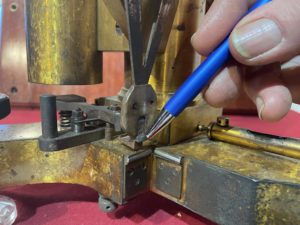Blog
Ballistic Chronograph, 1915

BALLISTIC CHRONOGRAPH
James Pitkin & Co, London, C 1915, Le Boulenge type.
Patented in 1874, the Le Boulenge ballistic chronograph was the most accurate way to find the speed of bullets until electronics changed everything, but that was well into the 20th century. Here, John explains how this device works.
First, the long and short rods are dropped from their respective electro magnets simultaneously. The short rod falls into the cylindrical pocket below where it trips a spring-loaded chisel. This darts out and makes a mark on the copper sleeve of the long rod as it passes by.
Then the circuits are changed so that the electricity comes to each magnet through a wire screen. The rods are re-hung on the electromagnets.
A bullet is shot that passes through the screens, first breaking the wiring to the long rod’s magnet, so that it starts falling.

The bullet then passes through the second screen, releasing the short rod, which again triggers the chisel to make a second mark on the long rod.
The difference is that since the short rod started a little later than the long one, the mark is made higher up on the long rod. Since we know that the acceleration of gravity is 32 feet per second per second, we can calculate the time the bullet took to travel between the screens.

Since we know the distance between the screens (after all, we put them there, didn’t we?), we divide the distance by the time which gives us the speed.
stay up to date
Want more content from the American Precision Museum?
Sign up to receive news straight to your inbox!
By submitting this form, you are consenting to receive marketing emails from: . You can revoke your consent to receive emails at any time by using the SafeUnsubscribe® link, found at the bottom of every email. Emails are serviced by Constant Contact


